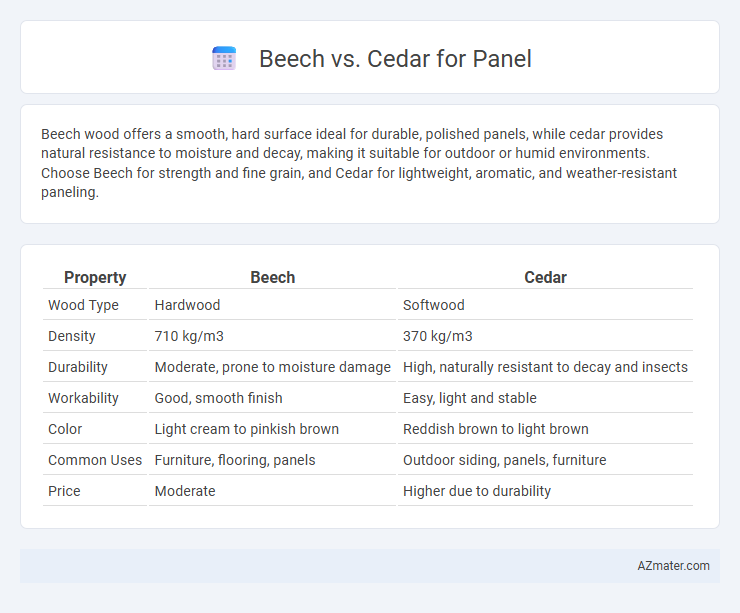Beech wood offers a smooth, hard surface ideal for durable, polished panels, while cedar provides natural resistance to moisture and decay, making it suitable for outdoor or humid environments. Choose Beech for strength and fine grain, and Cedar for lightweight, aromatic, and weather-resistant paneling.
Table of Comparison
| Property | Beech | Cedar |
|---|---|---|
| Wood Type | Hardwood | Softwood |
| Density | 710 kg/m3 | 370 kg/m3 |
| Durability | Moderate, prone to moisture damage | High, naturally resistant to decay and insects |
| Workability | Good, smooth finish | Easy, light and stable |
| Color | Light cream to pinkish brown | Reddish brown to light brown |
| Common Uses | Furniture, flooring, panels | Outdoor siding, panels, furniture |
| Price | Moderate | Higher due to durability |
Introduction to Beech and Cedar Wood
Beech wood is a dense, fine-grained hardwood prized for its smooth texture and pale color, making it ideal for furniture and interior paneling. Cedar wood, known for its aromatic scent and natural resistance to decay and insects, offers a lightweight yet durable option with a distinctive reddish hue. Both woods serve well in panel applications, with beech favored for its strength and uniformity, while cedar excels in environments requiring moisture resistance and a warm aesthetic.
Key Characteristics of Beech Wood
Beech wood is renowned for its hardness, fine grain, and smooth texture, making it ideal for paneling that requires durability and a refined finish. Its light color with a subtle pinkish hue enhances interior aesthetics while providing excellent resistance to wear and indentation. Beech wood's stability and ease of staining allow for versatile design options compared to cedar, which is softer and naturally aromatic but more prone to dents and scratches.
Key Characteristics of Cedar Wood
Cedar wood is renowned for its natural resistance to decay, insect infestations, and moisture, making it highly durable for paneling applications. Its distinctive aromatic scent and rich reddish-brown color contribute to an attractive aesthetic, while its medium softness allows for easy cutting and shaping without compromising structural integrity. Cedar's dimensional stability reduces warping and shrinking, ensuring long-lasting and low-maintenance panels compared to harder woods like Beech.
Durability and Longevity Comparison
Beech wood offers moderate durability with good resistance to wear and impact, making it suitable for indoor paneling but prone to moisture damage over time. Cedar excels in longevity due to its natural oils that provide strong resistance to rot, insects, and decay, ideal for both indoor and outdoor panels. For long-term durability and maintenance, cedar panels outperform beech, especially in environments with high humidity or exposure to the elements.
Aesthetic Differences: Grain and Color
Beech wood features a tight, straight grain pattern with a pale cream to light reddish-brown color, providing a smooth and uniform appearance ideal for sleek, modern panels. Cedar offers a more pronounced, varied grain with rich reddish hues and aromatic qualities, adding warmth and character to rustic or traditional panel designs. The subtle contrast between Beech's consistent light tone and Cedar's vibrant, textured surface allows for distinct aesthetic choices based on desired ambiance and style.
Workability and Ease of Installation
Beech wood offers excellent workability due to its fine, tight grain and uniform texture, making it easy to cut, sand, and shape for paneling projects. Cedar is also user-friendly but tends to be softer and more prone to dents, which can affect durability during installation. While beech panels provide a smooth, stable surface ideal for precise fitting, cedar's lightweight nature facilitates easier handling and quicker installation in confined spaces.
Resistance to Moisture, Decay, and Insects
Beech wood offers moderate resistance to moisture but is more prone to decay and insect damage compared to cedar, making it less ideal for environments with high humidity or insect presence. Cedar excels in natural resistance to moisture, decay, and insects due to its inherent oils and tight grain structure, enhancing its durability in outdoor or damp applications. The superior rot and pest resistance of cedar paneling often result in lower maintenance and longer lifespan compared to beech.
Maintenance and Care Requirements
Beech panels require regular sealing to protect against moisture and maintain their smooth, light finish, making them moderately high-maintenance compared to other hardwoods. Cedar panels offer natural resistance to rot, insects, and moisture, reducing the need for frequent treatments and making them ideal for low-maintenance applications. Both woods benefit from periodic cleaning and appropriate finishes, but cedar's inherent durability often translates to lower overall maintenance costs and effort.
Environmental Impact and Sustainability
Beech wood, sourced from fast-growing deciduous trees, offers a more sustainable option for paneling due to its rapid regrowth and widespread availability, resulting in lower environmental impact compared to cedar. Cedar, while naturally resistant to decay and pests, often comes from slower-growing coniferous trees, making its harvesting less sustainable and impacting carbon sequestration negatively. Choosing beech panels supports responsible forestry practices by promoting renewable resources and reducing deforestation risk in sensitive ecosystems.
Cost Comparison and Value for Money
Beech panels are generally more affordable than cedar, offering a cost-effective option for budget-conscious projects while maintaining durability and a smooth finish. Cedar panels, although higher in price, provide superior natural resistance to decay and insect damage, ensuring longer-lasting value especially in outdoor or humid environments. The choice between beech and cedar depends on balancing initial expenditure against long-term performance and maintenance costs for optimal value.

Infographic: Beech vs Cedar for Panel
 azmater.com
azmater.com